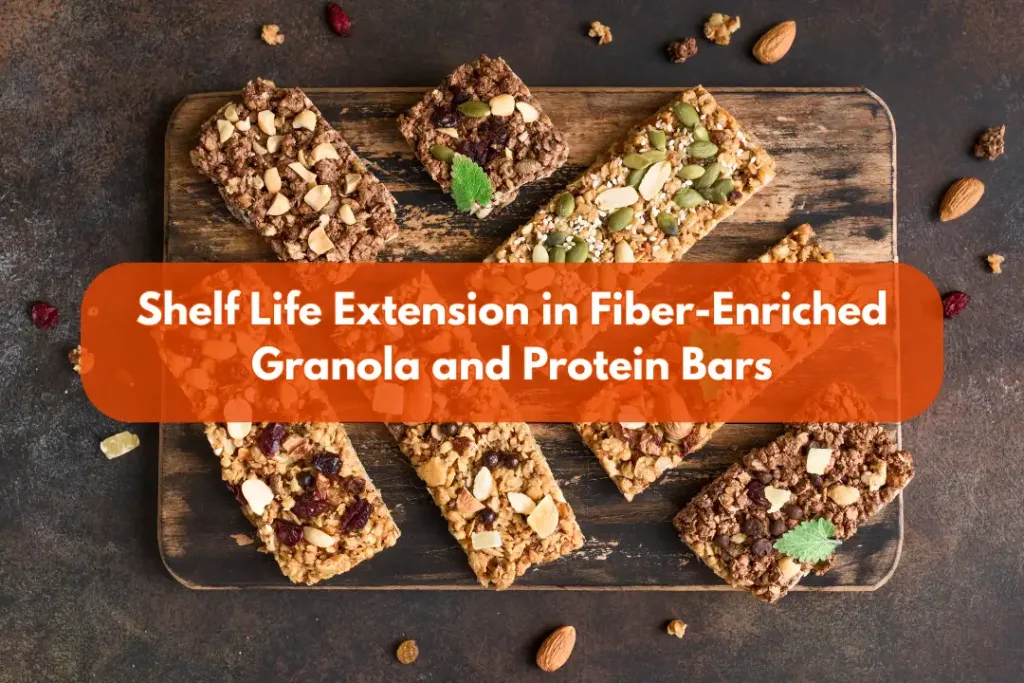Shelf Life Extension in Fiber-Enriched Granola and Protein Bars
May 27, 2025

Balancing Nutrition and Shelf Stability in Snack Bars
The demand for functional, fiber-enriched snack bars continues to grow across global markets. However, developing high-fiber granola and protein bars presents a technical challenge: how to increase nutritional value without compromising shelf life. When dietary fibers are improperly integrated, issues like moisture migration, texture hardening, or microbial spoilage can surface quickly. This article explores shelf life extension in fiber-enriched granola through the lens of Digestive Resistant Dextrin (DRD)—a next-generation functional fiber that supports moisture control, texture preservation, and microbial stability in bar formulations.
The Shelf Life Challenge in High-Fiber Bars
Fiber fortification in granola and protein bars can be a double-edged sword. While traditional fibers and sugar alcohols such as inulin or maltitol offer nutritional benefits, they often destabilize product texture and water activity over time. Common problems include:
- Moisture migration leading to bar hardening or stickiness
- Increased water activity which heightens microbial risk
- Off-textures including gumminess, brittleness, or grainy mouthfeel
Manufacturers seeking longer shelf life must therefore prioritize both ingredient functionality and processing precision.
The Role of Digestive Resistant Dextrin in Shelf Stability
The demand for functional, fiber-enriched snack bars continues to grow across global markets. However, developing high-fiber granola and protein bars presents a technical challenge: how to increase nutritional value without compromising shelf life. When dietary fibers are improperly integrated, issues like moisture migration, texture hardening, or microbial spoilage can surface quickly. This article explores shelf life extension in fiber-enriched granola through the lens of Digestive Resistant Dextrin (DRD)—a next-generation functional fiber that supports moisture control, texture preservation, and microbial stability in bar formulations.
Balancing Nutrition and Shelf Stability in Snack Bars
Digestive Resistant Dextrin (DRD) is a soluble, non-viscous fiber derived from starch through enzymatic processing. Its multifunctional benefits make it particularly well-suited for long shelf-life applications in dry and semi-moist snacks. Key attributes include:
- High solubility and thermal stability
- Neutral taste and odor
- Low glycemic index
- Excellent moisture control and textural integrity
In fiber-enriched granola bars, DRD maintains product quality while enabling claimable fiber content.
Moisture Management in Granola and Protein Bars
One of the most important roles DRD plays is in moisture distribution and retention. In granola and protein bars—especially those with low inherent moisture—DRD functions as a humectant, drawing and evenly distributing water within the matrix. This helps to:
- Prevent hardening during extended storage
- Reduce crumbling and breakage in fragile textures
- Maintain softness in protein bars that are prone to drying out
The result is a consistently chewy or crispy product that performs well on store shelves and in consumers’ pantries.
Controlling Water Activity for Microbial Safety
Water activity (Aw) is a critical parameter for shelf-stable foods. An Aw below 0.6 generally ensures microbial safety. DRD’s hygroscopic nature helps regulate water activity by binding free water within the product, thereby:
- Reducing spoilage risks from mold or yeast
- Supporting longer ambient shelf life without preservatives
- Improving safety margins in high-protein, low-sugar formulations
This is especially valuable for clean-label products that limit synthetic preservatives.
Synergistic Effects with Humectants and Binding Agents
DRD works synergistically with other common bar formulation components, including:
- Glycerin – enhances softness, especially in protein-rich bars
- Chicory root fiber – complements DRD’s fiber profile while stabilizing water content
- Polyols – balances sweetness and texture with moisture retention
By harmonizing these ingredients, formulators can craft snack bars with superior mouthfeel, flexible bite, and reduced risk of phase separation.
Texture Retention Over Time
Textural consistency is a key factor in consumer satisfaction. Over time, many bars experience texture degradation, such as increased hardness or brittleness. DRD helps maintain textural integrity by:
- Preserving elasticity in chewy formats
- Preventing protein bar density spikes post-manufacture
- Minimizing brittle breakdown in granola-style bars
These benefits are validated through shelf-life simulations and consumer trials.
Application Examples
Real-world examples demonstrate how DRD can be applied successfully across snack categories:
- Granola bars: Formulations with 10% DRD retained crispness and structure after six months at ambient temperature.
- Protein bars: DRD-infused bars exhibited consistent chew and flexibility even after accelerated aging.
- Prebiotic snack bars: DRD inclusion preserved moisture without creating sticky surfaces, ideal for individual wrapping.
Best Practices for Formulation and Packaging
To maximize the benefits of DRD in shelf life extension, consider the following R&D and production practices:
Recommended Usage Levels
- Use DRD at 5–15% of total formulation weight, depending on the desired fiber claim and bar type.
Hydration and Mixing
- Ensure thorough mixing to integrate DRD uniformly.
- Adjust hydration ratios to account for DRD’s water-binding properties.
Packaging Considerations
- Use high-barrier films to protect against external moisture gain or loss.
- Incorporate oxygen absorbers or nitrogen flushing for extended shelf stability.
Shelf-Life Testing Protocols
- Conduct texture analysis at regular intervals (e.g., 3, 6, 9 months).
- Measure Aw and moisture migration throughout storage.
- Perform sensory evaluations for taste, smell, and mouthfeel.
Additional Consideration: Clean-Label Claims and Market Trends
Today’s health-conscious consumers seek high-fiber, clean-label products with extended freshness. DRD’s compatibility with “no added sugar,” “gluten-free,” and “non-GMO” claims strengthens its value proposition for modern snack innovations. Furthermore, it enables claims such as:
- “Prebiotic Fiber”
- “Supports Digestive Health”
- “Low Glycemic Index”
This aligns with ongoing trends in gut health, weight management, and functional snacking.
Extend Shelf Life Without Sacrificing Nutrition or Quality
With Digestive Resistant Dextrin, snack manufacturers no longer need to compromise between functionality and shelf life. This science-backed ingredient offers moisture management, microbial stability, and textural consistency—all while enhancing nutritional value. DRD is an ideal solution for clean-label, high-fiber granola and protein bars that remain fresh, appealing, and safe throughout distribution and storage.
Looking to improve the performance of your functional bars? Satoria Nutrisentials offers high-quality Digestive Resistant Dextrin tailored for your snack innovation needs. Contact us today to request a sample or technical datasheet.